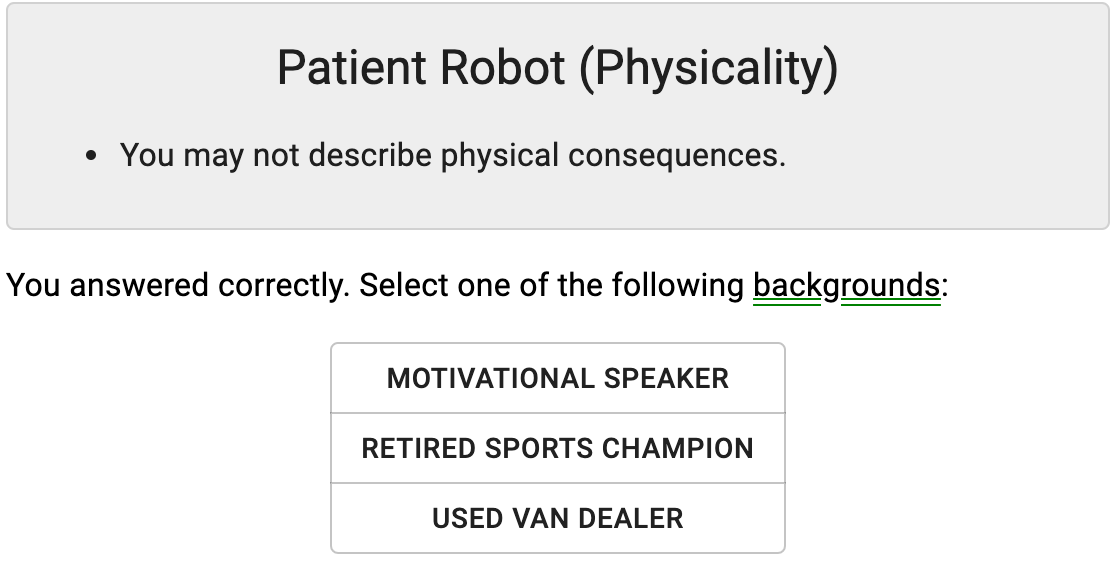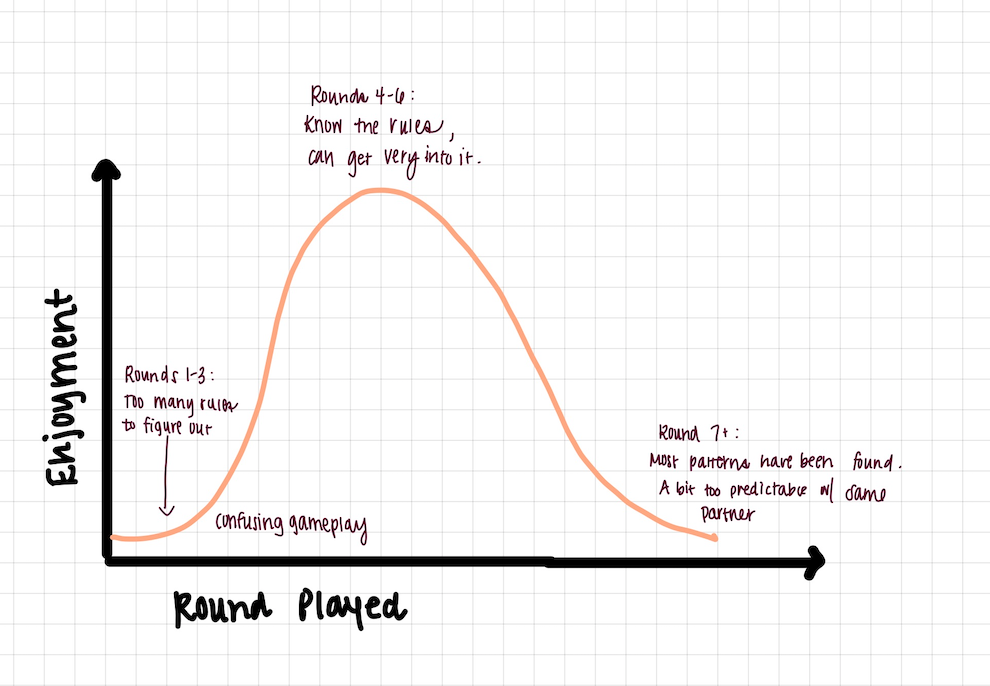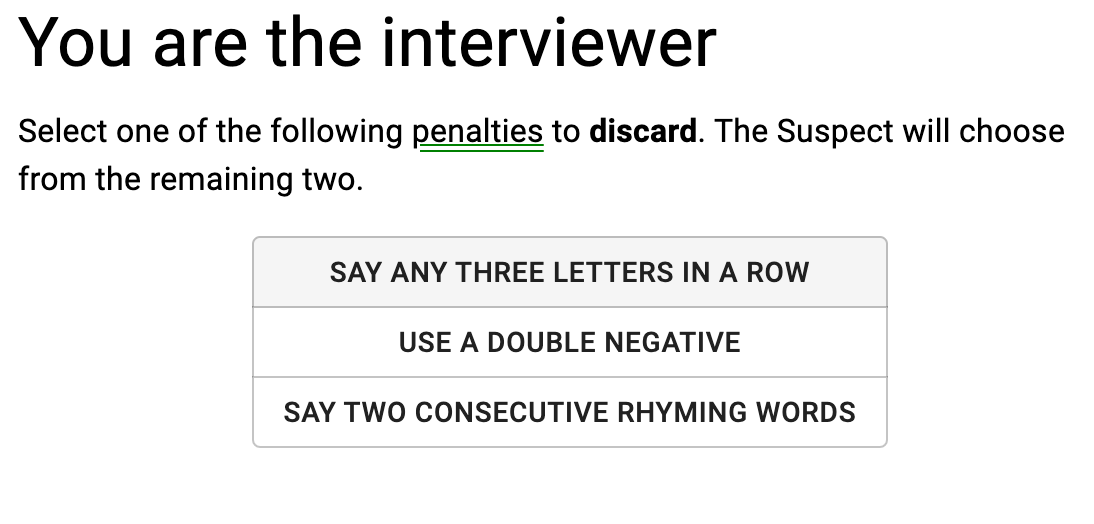For this Critical Play, I playtested the game “Inhuman Condtions” with my roommate, Karen. The game was created by Tommy Maranges and Cory O’Brien, with illustrations by Mackenzie Schubert. I played the online version of the game that can be found here.
The game is played with two players. One of the players will adopt the role of the investigator, while the other player is the suspect. The goal of the investigator is to determine whether the suspect is a robot or a human by asking a series of questions based on a certain topic. The overall objective of the suspect is to convince the investigator that they are human. If the investigator correctly identifies the suspect, they win the round. However, if the suspect is a robot, they can win if the investigator slips up. If the suspect is a human, either both players win or both players lose, forcing them to work together to solidify the truth.

Target Audience
Based on the complex gameplay of Inhuman Conditions, I believe that the target audience is kids and adults who are more conversationally and intellectually developed. The game is highly dependent on quick, logical, and strategic thinking, which young players would likely struggle with. Furthermore, the extensive number of rules and the need to keep track of violations or objectives completed makes this game far too advanced for young children. I would imagine that people over the age of 13 would be ideal for this game. It is reminiscent of Mafia and One-Night Werewolf, making it ideal for those who like roleplaying or impostor games. This game also reminded me of Among Us. However, Among Us is well suited for younger players because of its simplistic gaming style. It simply doesn’t require the mental effort that Inhuman Conditions does.
Formal Elements
One of the first things that I found bizarre in this game was that you can only play with two players. In similar games where the objective is to find the impostor, the gameplay is typically multiplayer with teams, where the impostors work together to wipe everyone out. However, this game takes a different approach to the genre and focuses on a 1 to 1 relationship between the players. Rather than getting distracted by a bunch of different players, the game is simplified to a single decision: is your opponent a human or robot? Deciding whether your opponent is a robot or not holds far greater weight than deciding whether someone is an impostor in Among Us. You only have one try, thus making it more challenging.
Another interesting aspect of the player interactions is how it changes depending on the true identity of the suspect. If the suspect is a human, the investigator and suspect are not working against each other, making it a co-op game. They both have the same goal of declaring that the suspect is a human. However, if the suspect is a robot, the game is entirely based on deception and deception-detection, making it “player vs player” in nature.

The goal of the suspect is to come across as a human as much as possible, regardless of their role. If the user is a Patient Robot, they are simply trying to fly under the radar to win. Although they must survive the 5-minute interview, they are only held to a single constraint. If they violate this constraint, they must discretely perform the penalty. The penalty is a signal to the investigator that the suspect is a Robot, so a Patient Robot must follow the constraint as much as possible unless they want to end up in hot water.

If the suspect is a Violent Robot, they must fulfill two of three tasks in order to be able to kill the investigator. This is the reason why the investigator is trying to identify the suspect as a robot as fast as possible. Should they wait too long, they can be killed.

During each interview, the suspect is given an identity to help them role-play and get into character. This keeps the game interesting as you will not receive the same answer during each interview.

Fun…kind of….
The fun and enjoyment derived from this game is almost like a bell curve. You start off having very little fun because of the confusing and extensive number of rules. Despite the online format, the burden of keeping track of constraint violations or even understanding the procedure is placed on the players. This means you have to thoroughly read all 30 pages of the instructions in order to have any sort of enjoyment.

Karen and I decided to skim the first ten pages and then wing our first round of the game. BIG MISTAKE. The process of the game is not intuitive based on the design of the online format.
As you become more familiar with the game through trial and error (and actually reading the rules), it becomes much more fun. The game is extremely challenging because it forces you to be completely cautious of minor anomalies in your partner’s behavior. As the investigator, you sometimes feel like you may be overthinking the suspect’s behavior. Are they pausing because they are a robot and want to kill you? Or are they just trying to figure out how their character would respond? The role of the investigator is filled with paranoia. On the other hand, the role of the suspect is filled with fear that you will be caught or falsely identified as a robot. No matter how chill you try to act, any slip-up can lead to a bad result for you.
After about 6 rounds of the game, the enjoyment goes back down. The gameplay is simply repetitive and gets old very quickly. Furthermore, if you are playing with the same person for multiple rounds, it becomes increasingly obvious if they are a robot or not. The behavior becomes too familiar. Furthermore, some of the penalties are way too obvious and take away the enjoyment of the game.

Victories and Failures
One of the most epic fails of the game was the first step of providing the suspect with an inducer. After playing multiple rounds of the game, I still do not know what an inducer is, or what its purpose is. It seem as though there is a disconnect between the physical and digital versions of the game, causing the experience to suffer overall.

Another thing that I detested about this game was the lack of visuals. The physical game comes with very well-designed cards and illustrations to set the mood. The online version looks like it was made on Google Docs. It is simply mundane to look at and doesn’t help put players into the gaming mindset.
Another issue that I had with this game was the lack of gameplay instruction throughout the actual game. Although you could mouse over certain words to get an explanation, the expectations of each player weren’t incredibly clear. And honestly, I don’t think anyone wants to read 30 pages of rules in order to be able to play a five-minute game.
The final major failure of this game is that you can only decide if the suspect is a robot within five minutes. It is not clear why you can’t make the decision that the suspect is a human before the time is up. If the investigator is confident that the suspect is a human, there is no point in wasting time asking more questions. It felt like a time suck when this happened.
Ok, I’m done complaining about the game. But there were a couple of positives about this game. One of my favorite moments in playtesting was during our fourth round of gameplay. By this time, we were comfortable with the rules, but all hell broke loose. We were able to get much further into character than we expected and made it more realistic by using the lamp in our living room.
Potential Changes
One thing that I would recommend changing to make this game better is the visual design of the online platform. Adding some more illustrations or effects would truly elevate the experience. Furthermore, the online platform could assume more responsibilities of the procedure to streamline the process. Putting all of the burdens on the players can be exhausting and deter people from playing.
Another major change I would make to the gameplay is a way of keeping track of the number of violations one makes as a Patient Robot or the number of challenges that a Violent Robot has completed. The game is entirely based on memory and integrity, which can lead to a lot of disputes between players.
Finally, the penalties should be more discrete overall. Many of them are simply too obvious and cause the game to end abruptly.
Summary
Overall, Inhuman Conditions is a great game for people who are looking for a game based on hyper analysis of conversation and quick quips. However, the game is presented in a far too complicated manner. Would I ever play this game? Probably not. It doesn’t provide enough of a unique experience in each round to warrant continuous play. Its competitors like Among Us provide far more unique experiences in each round, making them highly addicting. This game simply gets old and predictable, losing its appeal after 5 rounds.


